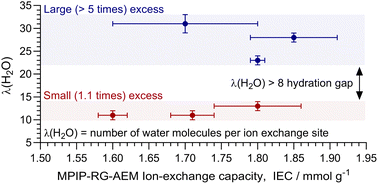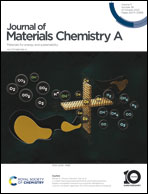Radiation-grafted anion-exchange membranes for CO2 electroreduction cells: an unexpected effect of using a lower excess of N-methylpiperidine in their fabrication†
Abstract
Giron Rodriguez et al. [ACS Sustainable Chem. Eng., 2023, 11, 1508] previously showed that radiation-grafted anion-exchange membranes containing N-benzyl-N-methylpiperidinium headgroups (MPIP-RG-AEM) are promising for use in CO2 electrolysis (cf. commercial and other RG-AEM types). For a more sustainable synthesis, MPIP-RG-AEMs have now been fabricated using a reduced 1.1 times excess of amine reagent (historically made using >5 times excess). A resulting RG-AEM promisingly had a bulk amination level that was comparable to those made with the traditional large excess. Unexpectedly, however, it had a significantly reduced water content, with two further batches showing that this observation was repeatable (and reproducible via measurements collected on a single batch using different techniques in different labs). The ionic conductivities of the RG-AEM made with a controlled 1.1 excess of amine were also lower, with higher activation energies. Terahertz time-domain spectroscopy measurements showed that the lower water uptake RG-AEMs, made with the 1.1 amine excess, contained smaller amounts of bulk water relative to bound water (a repeatable observation with different counter-anions). This lack of bulk water, yielding reduced water diffusion coefficients, led to a change in the water management when such RG-AEMs were tested in CO2 electrolysis cells, with significantly affected in situ performances. Small angle scattering data (X-ray and neutron) indicated that MPIP-RG-AEM fabrication with the 1.1 excess of amine reduced the size of the amorphous lamella domains on hydration, and this change is suspected to be the cause of the lower water uptakes and swelling. The finding that chemically similar AEMs can have significantly different hydration properties is potentially important to all ion-exchange membrane users and developers (beyond the CO2 electrolysis scope of this study).



 Please wait while we load your content...
Please wait while we load your content...